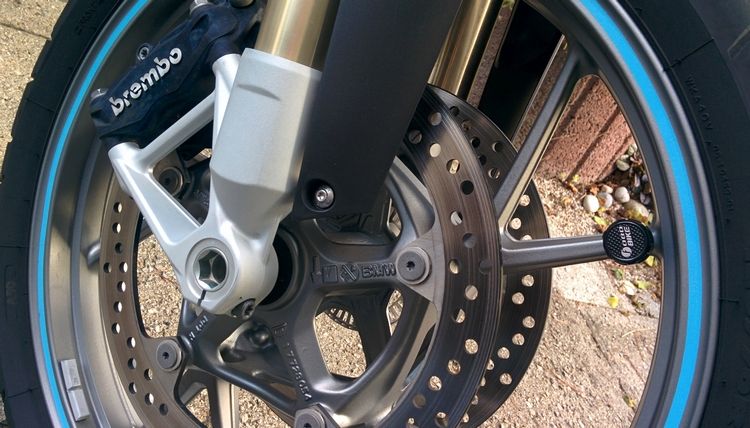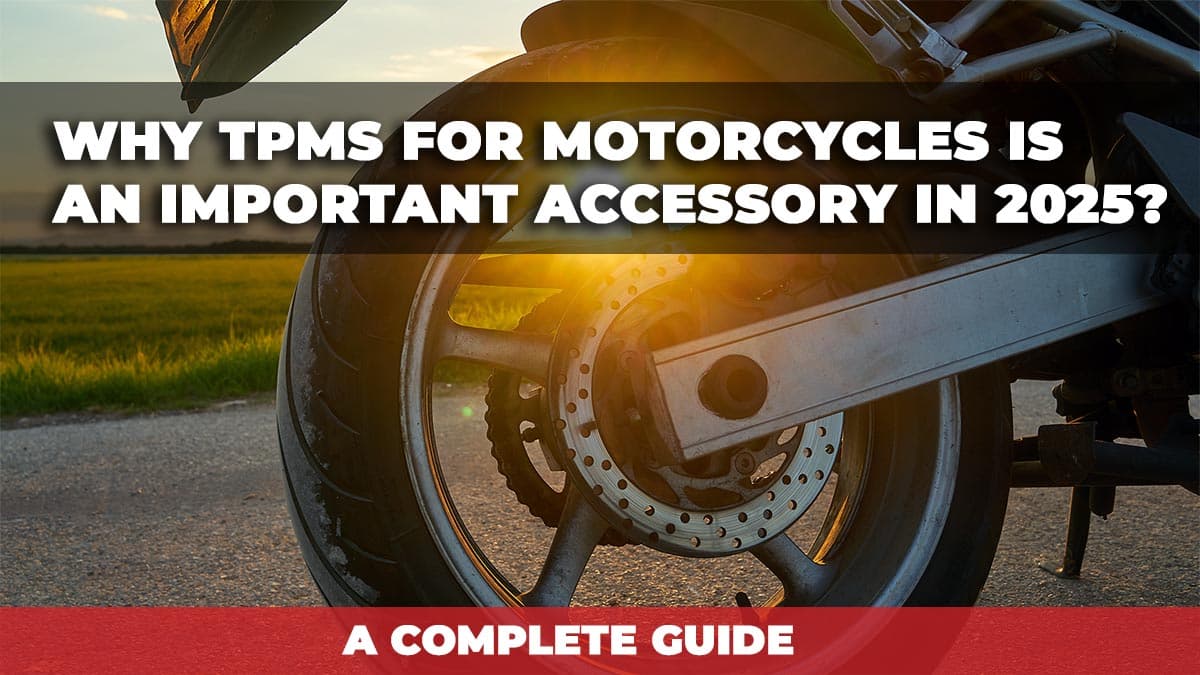MotoFolder is reader-supported. When you buy through links on our site, we may earn an affiliate commission at no extra cost to you. Read More.
Table of Contents
Introduction
Riding a motorcycle is not just about passion, thrill, or commuting convenience—it is also about safety. Among the various safety features available for two-wheelers, the Tire Pressure Monitoring System (TPMS) has emerged as one of the most valuable yet often overlooked accessories.
In this comprehensive article, we will explore what TPMS for motorcycles is, why it is essential for motorcycles, how it works, its benefits, and why every rider should consider investing in it.
What is TPMS?
TPMS (Tire Pressure Monitoring System) is a device designed to continuously monitor the air pressure and temperature inside motorcycle tires. It alerts the rider in real-time if the tire pressure falls below or rises above the recommended level.
There are two main types of TPMS:
1. Direct TPMS :
Uses sensors installed inside or outside the tire valve to measure actual air pressure and temperature.
2. Indirect TPMS :
Relies on wheel speed sensors to estimate pressure based on tire rotation differences.
For motorcycles, direct TPMS is more commonly used as it provides accurate and real-time readings.
Why Tire Pressure Matters in Motorcycles?
Unlike cars, motorcycles have only two wheels, which means tires are directly responsible for balance, grip, braking, and overall safety. Even a slight variation in tire pressure can affect the handling of the motorcycle.
Effects of Incorrect Tire Pressure:
- Low Pressure: Causes poor fuel efficiency, unstable cornering, sluggish handling, and a higher chance of tire blowout.
- High Pressure: Reduces grip, increases braking distance, and makes the ride uncomfortable.
- Fluctuating Pressure: Leads to uneven tire wear, reduced lifespan, and unexpected breakdowns.
According to the team of Motofolder, this makes TPMS an essential accessory to maintain optimal tire health and rider safety.
Importance of TPMS for Motorcycles

1. Enhances Rider Safety
The foremost reason to install Motorcycle TPMS is safety. A sudden tire blowout at high speed can be fatal for riders. With TPMS, you get instant alerts about abnormal tire conditions, allowing you to stop before a disaster occurs.
2. Improves Fuel Efficiency
Underinflated tires increase rolling resistance, which forces the engine to consume more fuel. By maintaining the correct tire pressure with TPMS guidance, riders can save fuel over the long run.
3. Extends Tire Life
Tires are expensive motorcycle components. Riding with improper tire pressure leads to uneven wear and reduces lifespan. TPMS for motorcycles help keep them in the recommended range, thus extending their durability.
4. Provides Real-Time Monitoring
Unlike manual checking with a pressure gauge, TPMS continuously monitors tire health and provides instant updates. Many modern TPMS units connect with mobile apps, giving riders pressure data at their fingertips.
5. Prevents Unexpected Breakdowns
A flat tire in the middle of nowhere is every rider’s nightmare. TPMS minimizes this risk by giving early warnings, ensuring timely refilling or repairs.
6. Ideal for Long-Distance Riders
Touring enthusiasts and long-distance riders benefit the most. With Motorcycle TPMS, riders don’t need to stop frequently to check tires manually—it ensures peace of mind during long journeys.
Read more about Mastering Motorcycle Safety and Performance by Motorcycle TPMS.
How TPMS for Motorcycles work?
- Sensors Installed – Small sensors are installed either inside the tire or on the valve cap.
- Data Collection – Sensors continuously measure tire pressure and temperature.
- Signal Transmission – Data is sent wirelessly to a receiver or mobile app.
- Alerts Generated – If pressure falls outside the safe range, visual or audible alerts notify the rider.
Most TPMS devices today come with digital displays or mobile connectivity, making it easy for riders to track their tire condition in real-time.

Benefits of Using Motorcycle TPMS
Let’s look at the broader advantages of having a TPMS installed:
- Accident Prevention – Reduces the chances of tire-related crashes.
- Comfortable Riding Experience – Properly inflated tires ensure smooth handling and better shock absorption.
- Eco-Friendly – Optimized fuel consumption lowers carbon footprint.
- Peace of Mind – Riders can focus on the journey without constantly worrying about tires.
- Cost Savings – Lower fuel costs, fewer tire replacements, and reduced maintenance expenses.
Common Myths About Motorcycle TPMS
Myth 1: “I can check tire pressure manually, I don’t need TPMS.”
Reality: Manual checks are useful, but not practical every time you ride. TPMS offers real-time monitoring, something a manual gauge cannot provide.
Myth 2: “TPMS is only useful for cars, not bikes.”
Reality: Motorcycles are more vulnerable to tire failures because they have only two wheels. TPMS for motorcycles is even more critical.
Myth 3: “TPMS drains battery quickly.”
Reality: Modern TPMS sensors are designed to consume minimal power. Most use replaceable coin batteries that last 1–2 years.
Who Should Use TPMS?
- Daily Commuters: Ensures safe city rides.
- Touring Enthusiasts: Reduces worry during long trips.
- Sport Riders: Maintains performance and handling.
- Delivery Riders: Prevents delays and ensures safety during work.
Essentially, every rider can benefit from TPMS.

How to Choose the Right TPMS for Motorcycles?
When selecting a TPMS for your motorcycle, consider the following factors:
- Sensor Type – Internal (accurate but needs installation) or External (easy to install but exposed).
- Display Option – Handlebar-mounted screen or smartphone connectivity.
- Battery Life – Longer-lasting sensors reduce maintenance.
- Durability – Ensure a waterproof and dustproof rating for Indian roads.
- Brand & Warranty – Opt for reliable brands with good after-sales support.
Installation of TPMS in Motorcycles
- External TPMS: Simple DIY installation; just replace the valve caps with sensor caps.
- Internal TPMS: Requires professional help as sensors are mounted inside the tire.
Many riders prefer external TPMS for convenience, while performance riders often choose internal sensors for better accuracy.
Future of TPMS in Motorcycles
With rising awareness about road safety, TPMS is likely to become a standard accessory on upcoming motorcycles. Some premium bikes already come equipped with factory-fitted TPMS.
Additionally, with the integration of IoT and smart riding apps, TPMS will evolve further—providing predictive analysis, integration with GPS, and AI-based alerts for optimal riding safety.
Conclusion
Motorcycles demand constant care, and tire health plays the most critical role in ensuring safe and enjoyable rides. A Tire Pressure Monitoring System (TPMS) is no longer a luxury but a necessary accessory for every rider.
Stay safe on the road and always prioritize your well-being.
If you think you have some more points regarding the topic, then you should write them in the comment section below.
We are happy to hear from you.
“RIDE SAFE, LIVE SAFE“




